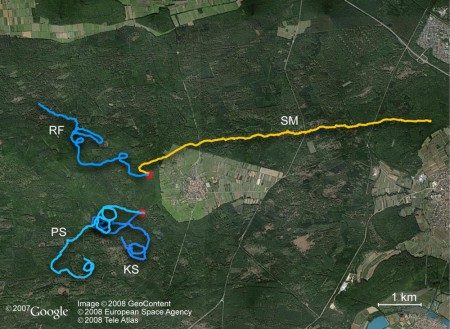
On the way to the office earlier this week, while listening to the radio, I heard report of an interesting study in human psychology. The study examined our innate sense of directionality – or, as it turns out, our utter lack of it. Robert Krulwich of National Public Radio interviewed German researcher Jan Souman of the Max Planck Institute.
The research project was simple enough. Souman blindfolded a bunch of volunteers, placed them in an empty expanse of desert sand, and asked them to walk in a straight line. Typically, volunteers could manage but 8 or 10 steps in the same direction. And then, inevitably, invariably, they veered to the left or the right – and were wandering about in circles.
So far, the results were not particularly surprising. What did surprise me, however, was that nothing seemed to correlate with the direction of the circles themselves. I might have thought, for example, that right-handed volunteers – presumably a bit stronger on their right side – would drift in a rightward direction. But not so. I might have thought that volunteers with one limb longer than the other – a common variability – would drift in the direction of their shorter appendage. Souman tested for this, too, padding volunteers’ right or left shoes and watching for some correlation. There was absolutely none. In fact, nothing seemed to predispose a meandering to the left or a wandering to the right. “There is something inside us that won’t stay straight,” Krulwich concluded simply. We are simply and naturally aimless, it would seem.
At this point, the interview made me think of churches.
Churches of every stripe and variety wander invariably; like our volunteers in the desert, the tendency is not so surprising. “All of us, whether insiders or outsiders, start out in identical conditions, which is to say that we all start out as sinners,” St. Paul explained. And then he quoted a passage from the Psalms:
“They’ve all taken the wrong turn;
they’ve all wandered down blind alleys.
No one’s living right;
I can’t find a single one.”
Romans 3:9,12; cf. Psalm 14:3 (The Message)
What may surprise us, however, is the lack of easy correlation between specific churchly characteristics and the direction of our wandering. We might have thought, for example, that “low church” people would wander less than the “high church” variety, or in some less dangerous way. Yet both seem capable of meandering in any direction whatsoever. We might have supposed that churches structured in “congregational” ways would find straighter paths than organizations structured in an episcopal sort of way. Or that black hymnals (or green, or red) would correlate with faithfulness better than another hue. Yet things like these make little difference in the end: churches wander in random and unpredictable ways, in any case. “There is something inside us that won’t stay straight.” Or to paraphrase St. Paul, we are naturally and dependably aimless.
Souman’s research didn’t end in aimlessness, however. One factor did correlate dependably with his volunteers’ sense of direction: an outward view to the horizon. If his subjects could see or feel the sun, for example, or glimpse a steady landmark on the horizon, then at last they could keep themselves straight.
My ancestors were farmers: farmers know all about this phenomenon. Whether you plow a field with a one-bottom plough behind a pair of oxen, like my grandfather did, or put sixteen blades into the ground behind a John Deere, as they do today – you cannot plough a straight line by looking down at the furrow. The only way to make it straight is to look ahead, toward the horizon, to something immovable.
And this, too, is true of the church. There is one antidote for our reliable tendency to wander. And it is not the perfection of our structures, or the color of our hymnals, or the caliber of our public worship. It is not our statements, or commitments, or lofty intentions. This is like attempting to plough straight by looking down at the furrow. The antidote for wandering is Jesus, only Jesus, keeping our eyes fixed upon the Savior.
At Christmas time, let us remember, the Savior of the world “became flesh and blood, and moved into the neighborhood (John 1:14, The Message). We don’t need a telescope to see him: he is right before our eyes. See him in his mother’s lap. See him calling the disciples to himself. See him spilling his blood for you. And follow him into the world.
Lest you wander.
[See an below animated summary of Robert Krulwich’s interview…]
We had this exact, unnerving, experience when we first moved to Cuenca. All the more to “turn your eyes upon Jesus.”
Thanks for your comment, Leslie!
So you felt as though you were blindfolded when you arrived in Cuenca? Or maybe that you couldn’t walk straight?
Sometimes the altitude can do this, too! 😉